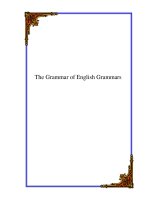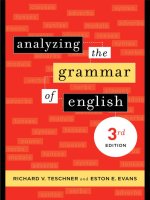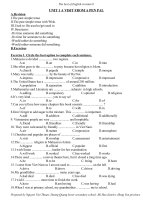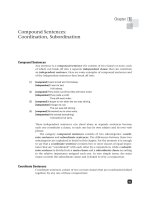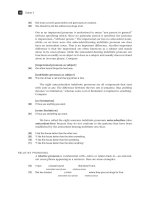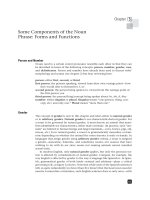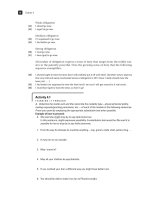An introductionto the grammar of english
Bạn đang xem bản rút gọn của tài liệu. Xem và tải ngay bản đầy đủ của tài liệu tại đây (2.2 MB, 216 trang )
An Introduction
to the Grammar
of English:
Syntactic arguments
and socio-historical
background
Elly van Gelderen
John Benjamins Publishing Company
An Introduction to the Grammar of English
An Introduction
to the Grammar of English
Syntactic arguments and
socio-historical background
Elly van Gelderen
Arizona State University
John Benjamins Publishing Company
Amsterdam / Philadelphia
8
TM
The paper used in this publication meets the minimum requirements of American
National Standard for Information Sciences – Permanence of Paper for Printed
Library Materials, ansi z39.48-1984.
Library of Congress Cataloging-in-Publication Data
Gelderen, Elly van.
An introduction to the grammar of English : syntactic arguments and socio-historical
background / Elly van Gelderen.
p. cm.
Includes bibliographical references and index.
1. English language--Grammar. 2. English language--Grammar, Historical. 3. English
language--Social aspects. 4. English language--Syntax. I. Title.
PE1106.G38 2002
428.2-dc21
2002021580
isbn 90 272 2588 5 (Eur.) / isbn 1 58811 200 4 (US) (Hb; alk. paper)
isbn 90 272 2586 9 (Eur.) / isbn 1 58811 157 1 (US) (Pb; alk. paper)
© 2002 – John Benjamins B.V.
No part of this book may be reproduced in any form, by print, photoprint, microfilm, or any
other means, without written permission from the publisher.
John Benjamins Publishing Co. · P.O. Box 36224 · 1020 me Amsterdam · The Netherlands
John Benjamins North America · P.O. Box 27519 · Philadelphia pa 19118-0519 · usa
Table of contents
Preface
List of tables
Glossary
ix
xiii
xv
1
Introduction
1.
Examples of linguistic knowledge 1
2.
How do we know so much? 5
3.
Examples of social or non-linguistic knowledge 6
4.
Conclusion 7
2
Categories
1.
Lexical categories 11
2.
Grammatical categories 17
3.
Pronouns 20
4.
What new words and loanwords tell us 21
5.
Conclusion 22
11
3
Phrases
1.
The phrase 31
2.
Phrases in the sentence 40
3.
Coordination of phrases 41
4.
Finding phrases 43
5.
Building trees 44
6.
Conclusion 46
31
Review Chapters 1–3
1
57
vi
Table of contents
4
Functions in the sentence
1.
The different functions and how they are realized 61
2.
Verbs and functions 66
3.
Trees 67
4.
Light verbs (Optional) 69
5.
Conclusion 69
61
5
More functions, of prepositions and particles
1.
Adverbials 79
2.
Prepositional verbs 83
3.
Phrasal verbs 84
4.
Phrasal prepositional verbs (Optional) 85
5.
Objects and adverbials 86
6.
Conclusion 88
79
6
The structure of the Verb Group in the VP
1.
Auxiliary verbs 97
2.
The order of auxiliaries and affix hop 103
3.
Finiteness 105
4.
Conclusion 107
97
Review Chapters 4–6
113
7
Finite clauses: Embedded and coordinated
1.
Sentences and clauses 119
2.
The functions of clauses 120
3.
The structure: S¢ (pronounced: S-bar) 120
4.
Coordinate sentences 124
5.
Terminological labyrinth 125
6.
Conclusion 125
119
8
Non-finite clauses
1.
Non-finite clauses 135
2.
The functions of non-finites 136
3.
The structure: S¢? 137
4.
Coordinating non-finites 139
5.
Conclusion 140
135
Table of contents
Review of Chapters 7 and 8
147
9
The structure of the NP, AdjP, AdvP, and PP
1.
The structure and function of AdjP, AdvP, and PP 149
2.
The structure of the NP and functions inside it 151
3.
Arguments for distinguishing complements from
modifiers 154
4.
Conclusion 156
149
10 Clauses as parts of NPs and AdjPs
1.
NPs and AdjPs as compared to PPs and AdvPs 167
2.
NPs: Modifier (Relative) and complement clauses 168
3.
More on RCs 172
4.
AdjPs: Complement clauses 173
5.
Conclusion 174
167
11 Special sentences
1.
Questions/interrogatives 181
2.
Exclamations 183
3.
Topicalization, passive, cleft, and pseudo-cleft 183
4.
Conclusion 184
181
Review Chapters 9–11
189
Further reading
195
References
199
vii
Preface
To the student
You don’t have to read long novels in this course — no Middlemarch or War
and Peace. There isn’t much memorization either. It should be enough if you
become familiar with the keywords at the end of each chapter (use the glossary,
but don’t overemphasize the importance of terminology). The focus is on
arguments, exercises, and tree drawing. You need to do this from the first week
on, however, and you may also have to read a chapter more than once. The
course is not particularly difficult but once you get lost, go for help! The book
is divided in four parts, with review sections after each. Chapter 1 is the
introduction; skip the ‘justification’ if you want.
Justification and thanks
This grammar is in the tradition of the Quirk family of grammars, such as the
work of Huddleston, Burton-Roberts, Aarts & Wekker. Quirk, Greenbaum,
Leech, and Svartvik’s work in turn is based on a long tradition of grammarians
such as Jespersen, Kruisinga, Poutsma, and Zandvoort.
While following the traditional distinction between function (subject,
object, etc.) and realization (NP, VP, etc), the present book focusses on the
structure and makes the function derivative, as in more generativist work,
making it unlike recent grammars such as Verspoor & Sauter (2000). Its focus
on structure can be seen in the treatment of the VP as consisting of the verb and
its complements. Abstract discussions such as what a constituent is are largely
avoided (in fact, the term constituent is since it is a stumbling block in my
experience), and the structure of the NP and AP is brought in line with that of
the VP: NPs and APs have complements as well as modifiers.
x
An Introduction to the Grammar of English
A clear distinction is made between lexical and functional (here called
grammatical) categories. Lexical categories project to phrases and these phrases
have functions at sentence level (subject, predicate, object). As in traditional
grammar, but unlike in generative grammar, functional categories (determiner,
auxiliary, coordinator, and complementizer) do not project to phrases and have
no function at sentence level (they function exclusively inside a phrase and
connect clauses and phrases). Hence, determiner, auxiliary, coordinator and
complementizer express realization as well as function. This distinction is of
course not always clearcut, e.g. adverbs, pronouns, and some prepositions are
in between. I do bring this up.
On occasion, I do not give a definitive solution to a problem because there
isn’t any. This lack of explanation can be caused either by an analysis remaining
controversial, as in the case of ditransitive verbs and coordinates, or by the
continual changes taking place in English (or any other language for that
matter). Instead of giving one solution, I discuss some options. I have found
that students become frustrated if, for instance, they can reasonably argue that
a verb is prepositional in contexts where ‘the book says’ it is an intransitive verb.
Therefore, the emphasis in this book is on the argumentation, and not on presenting ‘the’ solution. The chapter where I have been quite conservative in my
analysis is Chapter 6. The reason is that to provide the argumentation for a nonflat structure involves theta-theory and quantifier-float and this leads too far
afield.
Unlike Quirk et al. (1985), this grammar starts with a chapter on intuitive
linguistic knowledge and provides an explanation for it based on Universal
Grammar. Also different is the discussion of prescriptive rules, at the end of
each chapter. In my experience, students want to know what the prescriptive
rule is. Strangely enough, they don’t want the instructor to tell them that
linguistically speaking, there is nothing wrong with splitting an infinitive or
using like as a complementizer. Adding those topics is a compromise to them.
I have not integrated them in the chapters since I want to keep descriptive and
prescriptive rules separate. The topics, obviously, cannot cover all traditional
usage questions, such as the ‘correct’ past participle or subjunctive forms. They
are added to give a flavor for the kinds of prescriptive rules around.
The chapters in this book cover ‘standard’ material: categories, phrases,
functions, and embedded sentences. There are a few sections that I have labelled
optional, since, depending on the course, they may be too complex. The last
chapter could either be skipped or expanded upon, depending on whether it is
appropriate to introduce S≤ or CP. It should be possible to cover all chapters in
Preface
one semester. The students I have in mind (because of my own teaching
background) are English, Humanities, Philosophy, and Education majors as
well as others taking an upper level grammar course in an English department
at a North American university, or those in an English department in a European country. Textbooks for such courses have ´‘grammar’ in their titles rather
than ´‘syntax’, and hence the title of this book. I am assuming students using this
book know basic ‘grammar’, for instance, the past tense of go, and the comparative of good. Students who do not have that knowledge should consult a work
such as O’Dwyer (2000).
Even though I know there is a danger in giving one answer where more than
one are sometimes possible, I have nevertheless provided answers to the
exercises. It is done to avoid having to go over all exercises in class. I hope this
makes it possible to concentrate on those exercises that are interesting or
challenging.
I would like to thank my students in earlier grammar courses whose
frustration with some of the inconsistencies in other books has inspired the
current work. I am sure this is not the first work so begun. I am extremely
grateful to Johanna Wood for long, helpful discussions which made me rethink
how to present fundamental questions and for suggesting the special topics.
Johanna also made extensive comments to the exercises. I also thank Harry
Bracken for his comments and encouragement, Viktorija Todorovska for major
editorial comments, Tom Stroik for supportive suggestions, Barbara Fennell for
detailed comments and insightful clarifications, and Anke de Looper of John
Benjamins for creative solutions regarding the published version. Other
suggestions on the e-text as well on the paper version and on the general project
by Dhira Mahoney, Lutfi Hussein, Jeff Parker, Laura Parsons, Mariana Bahtchevanova and Susan Miller were much appreciated.
xi
List of tables
Table 2.1: Some differences between N and V 14
Table 2.2: Differences between adjectives and adverbs 16
Table 2.3: Some quantifiers and determiners 18
Table 3.1: Determining phrases 43
Table 4.1: Subject tests 62
Table 4.2: A schema of the functions of NPs, VPs, and AdjPs 70
Table 5.1: Differences among Objects, Su/Obj Predicates, and Adverbials 86
Table 5.2: Verb types 89
Table 5.3: The functions of PPs and AdvPs 89
Table 6.1: Characteristics of auxiliary verbs 98
Table 6.2: Forms of to be 101
Table 6.3: Auxiliaries and their affixes 104
Table 6.4: The relationship between finite and lexical/auxiliary verb 107
Table 10.1: Restrictive and non-restrictive RCs 169
Glossary
At the end of each chapter, there is a list of key terms. These are the most
relevant and should be understood.
The glossary tries to be somewhat comprehensive, and lists key terms,
abbreviations, non-key terms, and some common terminology not used in this
book, e.g. attributive adjective, but perhaps used elsewhere. Don’t attempt to
memorize the glossary!
Adj¢
accusative case
Adjective-bar, intermediate category, see Chapter 9, Section 1.
The case of the object or prepositional object, only visible on pronouns in English, e.g. me, in He saw me, also called the objective case.
See special topic to Chapter 4.
active
A sentence in which the doer of the action is the subject, as in I saw
an elephant, see Chapter 4, Section 1.3.
Adj
= adjective, see below.
adjective
A word which often describes qualities, e.g. proud; it modifies a
noun, see Chapter 2, Section 1.2.
adjective complement Complement to an adjective, e.g. of him in proud [of him], see Chapter 9, Section 1.
AdjP
= Adjective Phrase: group of words centered around an adjective, e.g.
very nice, see Chapter 3, Section 1.3.
adjunct
Term not used in this book; alternative for ‘adverbial’, see there.
Adv
= adverb, see below.
adverb
E.g. proudly; it is similar to an adjective but it modifies a verb,
adjective, or other adverb, see Chapter 2, Section 1.2, whereas an
adjective modifies a noun.
adverbial
A function at sentence level providing the background on where,
when, how, and why the event described in the VP takes place, see
Chapter 5, Section 1.
AdvP
= Adverb Phrase: group of words centered around an adverb, e.g.
very nicely, see Chapter 3, Section 1.3.
affix
Cannot stand on its own, e.g. an ending such as -ing, see Chapter 2,
Section 1.1, Chapter 6, and Table 6.3.
1 Introduction
All of us know a lot about language. Most of the time, however, we are not
conscious of this knowledge. When we actually study language, we attempt to
find out what we know and how we acquire this linguistic knowledge. In this
chapter, a number of instances will be given of what speakers of English
intuitively know about the grammar of English, both about its sounds and its
structure. The remainder of the book focusses on syntax, i.e. the categories and
structures to account for our intuitive knowledge. The chapter also discusses
social, i.e. non-linguistic, rules. These are often called prescriptive rules and
some of these are dealt with as ‘special topics’ in this book.
1.
Examples of linguistic knowledge
1.1 Consonants and vowels
If you are a native speaker of English, you know when to use the article a and
when to use an. Speakers know how to do this correctly even though they might
not be able to formulate the rule, which says that the article a occurs before a
word that starts with a consonant, as in (1), and an occurs before a word that
starts with a vowel, as in (2). If a child is given a nonsense word, as in (3), the
child knows what form of the article to use:
1. a nice person, a treasure
2. an object, an artist
3. ovrite, cham
The rule for a(n) does not need to be taught explicitly in schools. It is only
mentioned in connection with words that start with h or u. Since teachers are
mainly worried about writing, they need to explain that what looks like a vowel
in (4) is not in speech and that the a/an rule is based on speech. So, the form we
2
An Introduction to the Grammar of English
choose depends on how the word is pronounced. In (4) and (6), the u and h are
not pronounced as vowels but in (5) and (7), they are:
4.
5.
6.
7.
a union, a university
an uncle
a house, a hospital
an hour
The same rule predicts the pronunciation of the in (8). Pronounce the words in
(8) and see if you can state the rule for the use of the:
8. The man, the table, the object, the hospital…
Examples (1) to (8) show the workings of a phonological (or sound) rule. The
assumption is that we possess knowledge of consonants and vowels without
having been taught the distinction. In fact, knowledge such as this enables us to
learn the sound system of the language.
Apart from the structure of the sound system, also called phonology, a
grammar will have to say something about the structure of words, or morphology. Native speakers are quite creative building words such as kleptocracy,
cyberspace, antidisestablishmentarianisms, and even if you have never seen them
before, knowing English means that you will know what these words mean
based on their parts. Words such as floccinaucinihilipilification, meaning ‘the
categorizing of something as worthless or trivial’, may be a little more difficult.
This book will not be concerned with sound (phonology) or with the structure
of words (morphology); it addresses how sentences are structured, often called
syntax, or grammar, as in this book. In the next subsection, some examples are
given of the syntactic knowledge native speakers possess.
1.2 Structure, auxiliaries, and movement
Each speaker of English has knowledge about the structure of a sentence. This
is obvious from cases of ambiguity where sentences have more than one
meaning. This often makes them funny. For instance, the headline in (9) is
ambiguous in that ‘cello case’ can mean ‘court case related to a cello’, or
‘someone called Cello’, or ‘a case to protect a cello’:
9. Drunk Gets Ten Months In Cello Case.
In (9), the word ‘case’ is ambiguous (lexical ambiguity). The headlines in (10) to
(12) are funny exactly because drops, left, waffles, strikes and idle can be ambiguous:
Chapter 1. Introduction
10. Eye drops o¬ shelf.
11. British left wa¬les on Falkland Islands.
12. Teacher strikes idle kids.
Word ambiguities such as (10) to (12) are often produced on purpose for a
certain effect, and are also called ‘puns’. Some well-known instances from Lewis
Carroll are the following:
“Mine is a long and sad tale!” said the Mouse, turning to Alice and sighing. “It
is a long tail, certainly,” said Alice, looking with wonder at the Mouse’s tail,
“but why do you call it sad?”
“How is bread made?” “I know that!” Alice cried eagerly. “You take some
flour–” “Where do you pick the flower?” the White Queen asked. “In a garden,
or in the hedges?” “Well, it isn’t picked at all,” Alice explained; “it’s ground–”
“How many acres of ground?” said the White Queen.
There are also sentences where the structure is ambiguous, e.g. (13), and the Hi
& Lois Cartoon below it:
13. Speaker A: I just saw someone carrying a monkey and an elephant go into
the circus.
Speaker B: Wow, that someone must be pretty strong.
Reprinted with special permission of King Feature Syndicate.
The aim of this book is to understand the structure of English sentences;
ambiguity is a major part of that, and in Chapter 3, more will be said about it.
Knowing about the structure is relevant in many cases, e.g. to ask a certain type
of question, a verb is moved to the front of the sentence, as from (14) to (15):
14. The man is tall.
15. Is the man tall?
3
4
An Introduction to the Grammar of English
This rule is quite complex since we can’t simply front any verb as (17) and
(18), both derived from (16), show. In (17), the first verb of the sentence is
fronted and this results in an ungrammatical sentence (indicated by the *); in
(18), the second verb is fronted and this is grammatical:
16. The man who is in the garden is tall.
17. *Is the man who in the garden is tall?
18. Is the man who is in the garden tall?
These sentences show that speakers take the structure of a sentence into account
when formulating questions (see also Chapter 3). We intuitively know that the
man who is in the garden is a single unit and that the second verb is the one we
need to move in order to make the question. This is not all, however. We also
need to know that not all verbs move to form questions, as (19) shows. Only
certain verbs, namely auxiliaries (see Chapter 6) and the verb to be, as in (15)
and (18), are fronted:
19. *Arrived the bus on time?
In another kind of question, it is relevant to know what function the questioned
word plays in the sentence. Thus, in (20) to (22), who is the object (see Chapter 4) of the verb meet. Without ever having been taught, we know that (22) is
ungrammatical. With some trouble, we can figure out what (22) means. There
is a story that Jane met someone and you believe this story. The speaker in (22)
is asking who that someone is. Sentence (22) is ungrammatical because who
moves ‘too far’. It is possible, but not necessary here, to make precise what ‘too
far’ means. The examples merely serve to show that speakers are aware of
structure without explicit instruction and that who moves to the initial position:
20. Who did Jane meet?
21. Who did you believe that Jane met?
22. *Who did you believe the story that Jane met?
Some readers might object to the use of who, rather than whom, in (20) to (22).
This use will be discussed in Chapter 10 and in the special topics to Chapters 4
and 10.
Thus, native speakers of English know that (a) sentences have a structure,
e.g. (16), (b) movement occurs in questions, e.g. (16) and (20), and (c) verbs
are divided into (at least) two kinds: verbs that move in questions (or auxiliary
verbs) and verbs that don’t move (or lexical verbs, as in (19)). More information on these three points will be given in Chapters 3, 11, and 6 respectively.
Chapter 1. Introduction
The other chapters deal with additional kinds of grammatical knowledge.
Chapter 2 is about what we know regarding categories; Chapter 4 is about
functions such as subject and object; Chapter 5 about adverbials; Chapter 9
about the structure of a phrase; and Chapters 7, 8 and 10 about the structure of
more complex sentences.
2. How do we know so much?
In Section 1, I discussed examples of what we know about language without
being explicitly taught. How do we come by this knowledge? One theory that
accounts for this was suggested by Noam Chomsky. He argues that we are all
born with a language faculty that when “stimulated by appropriate and continuing experience, … creates a grammar that creates sentences with formal and
semantic properties” (1975: 36). Thus, our innate language faculty (or Universal
Grammar) enables us to create a set of rules, or grammar, by being exposed to
(generally rather chaotic) language around us. The set of rules that we acquire
enables us to produce sentences we have never heard before. These sentences
can also be infinitely long (if we had the time and energy). Language acquisition, in this framework, is not imitation but an interplay between Universal
Grammar (UG) and exposure to a particular language.
This need for exposure to a particular language explains why, even though
we all start out with the same UG, we acquire slightly different grammars. For
instance, if you are exposed to a certain variety of Missouri or Canadian
English, you might use (23); if exposed to a particular variety of British English,
you might use (24); or, if exposed to a kind of American English, (25) and (26):
23.
24.
25.
26.
I want for to go.
You know as he left.
She don’t learn you nothing.
Was you ever bit by a bee?
Thus, “[l]earning is primarily a matter of filling in detail within a structure that
is innate” (Chomsky 1975: 39). “A physical organ, say the heart, may vary from
one person to the next in size or strength, but its basic structure and its function
within human physiology are common to the species. Analogously, two
individuals in the same speech community may acquire grammars that differ
somewhat in scale and subtlety… . [T]he products of the language faculty vary
depending on triggering experience, ranging over the class of possible human
5
6
An Introduction to the Grammar of English
languages (in principle). These variations in structure are limited, no doubt
sharply, by UG” (p. 38).
Hence, even though Universal Grammar provides us with categories such
as nouns and verbs that enable us to build our own grammars, the language we
hear around us will determine the particular grammar we build up. A person
from the 14th century who growing up has heard multiple negation, as in (27),
would have a grammar that allows multiple negation. The same holds for a person
from the 15th century who has heard (28). Please note that the original spelling has
been kept in older examples. The Modern English equivalent, given in the single
quotation marks, shows that we now need ‘any’ instead of another negative:
27. Chaucer, The Romaunt of the Rose, l. 560–1
Men neded not in no cuntre
A fairer body for to seke.
‘People did not need to seek a fairer person in any country’.
28. The Paston Letters, letter 45 (1452), p. 71
for if he had he ne nedid not to haue sent no spyes.
‘because if he had, he would not have needed to send any spies’.
Linguists typically say that one grammar is just as ‘good’ as any other. People
may judge one variety as ‘bad’ and another as ‘good’, but for most people
studying language, (23) through (26) are just interesting, not ‘incorrect’. This
holds for language change as well: the change from (27) and (28) to Modern
English is not seen as either ‘progress’ or ‘decay’, but in more neutral terms.
Society also has rules, which I call social or ‘non-linguistic’, and which we
need to take into account to be able to function. These are occasionally at odds
with the (non-prescriptive) grammars speakers have in their heads. This is
addressed in the next section.
3. Examples of social or non-linguistic knowledge
We know when not to make jokes, for instance, when filling out tax forms or
speaking with airport security people. We also know not to use words and
expression such as all you guys, awesome, I didn’t get help from nobody in formal
situations such as applying for a job. We learn when and how to be polite and
impolite; formal and informal. The rules for this differ from culture to culture
and when we learn a new language, we also need to learn the politeness rules
and rules for greetings, requests, etc.
Chapter 1. Introduction
When you are in informal situations (watching TV with a roommate),
nobody will object to ‘prescriptively proscribed’ expressions, as in (29). In
formal situations (testifying in court), you might use (30) instead:
29. I didn’t mean nothin’ by it.
30. I didn’t intend to imply anything with that remark.
The differences between (29) and (30) involve many levels: vocabulary choice,
e.g. intend rather than mean, phonology, e.g. nothin, and syntax, namely the
double negative in (29). People use the distinction between formal and informal
for ‘effect’ as well, as in (31):
31. You should be better prepared the next time you come to class. Ain’t no way
I’m gonna take this.
This book is not about the fight between descriptivism (‘what people really say’)
and prescriptivism (‘what some people think people ought to say’). As with all
writing or speech, it makes a number of stylistic choices, e.g. use of contraction,
use of ‘I’, the frequent use of passives, and avoidance of very long sentences.
This, however, is irrelevant to the main point which is to provide the vocabulary
and analytical skills to examine descriptive as well as prescriptive rules. The field
that examines the status of prescriptive rules; regional forms as in (23) to (26);
and formal and informal language, as in (31) to (30), is called sociolinguistics.
Some prescriptive rules are analysed in the special topics sessions at the end of
every chapter. The topics covered are adverbs used as adjectives and vice versa,
multiple negation, as in (29), case marking (e.g. It is me, between you and me),
split infinitives (to boldly go where …), the use of of rather than have (I should of
done that), subject-verb agreement, the preposition like used as a complementizer (like I said …), dangling modifiers, and the ‘correct’ use of commas.
4. Conclusion
This first chapter has given instances of rules we know without having been
taught, and offers an explanation about why we know this much (Universal
Grammar ‘helps’ us). Other chapters in the book provide the categories and
structures that we must be using to account for this intuitive knowledge. The
chapter also provides instances of social or non-linguistic rules. These are often
called prescriptive rules and some of these are dealt with as ‘special topics’ at the
end of each of the chapters. The key terms in this chapter are syntax; linguistic as
7
8
An Introduction to the Grammar of English
opposed to social or non-linguistic knowledge; descriptivism and prescriptivism;
formal as opposed to informal language; innate faculty; and Universal Grammar.
Exercises
A. Can you give an instance of innate linguistic knowledge?
B. Do you think the following sentences are prescriptively correct or not.
Why/why not?
32.
33.
34.
35.
36.
It looks good.
Me and my friend went out.
Hopefully, hunger will be eliminated.
There’s cookies for everyone.
Colorless green ideas sleep furiously.
Class discussion
C. Can you think of something you would say in an informal situation but not
in a formal one?
D. Discuss in class why prescriptively ‘correct’ constructions are often used in
formal situations.
E. You may have heard of best-selling ‘language mavens’ such as William
Safire or Edwin Newman. Safire is a political commentator who also writes
a weekly column in the Sunday New York Times. Titles of his books include
Good Advice, I Stand Corrected: More on Language, and Language Maven
Strikes Again. Newman, a former NBC correspondent, writes books entitled
A Civil Tongue and Strictly Speaking. These lead reviewers to say “Read
Newman! Save English before it is fatally slain” (from the backcover).
Discuss where you think these gurus or mavens get their authority.
F. Explain the ambiguity in (37) to (39):
37. light house keeper.
38. old dogs and cats.
39. Herma gave her dog biscuits.
Chapter 1. Introduction
Keys to the Exercises
A. Consonants and vowels: all languages have them and we use them in
building our linguistic rules.
B. –
–
–
–
–
(32) is correct since good is an adjective giving more information about
the pronoun it (see Chapter 2 and special topic).
(33) is not since the subject should get nominative case (see Chapter 4
and special topic).
(34) is not since hopefully is not supposed to be used as a sentence
adverb (see Chapter 5 and special topic of Chapter 2).
(35) is not since the verb is singular (is) and the subject is plural
(cookies). This violates subject-verb agreement (see Chapter 4 and
special topic to Chapter 9).
(36) is Noam Chomsky’s famous sentence. It is perfectly grammatical
and shows that syntax and grammar are separate from meaning.
9

